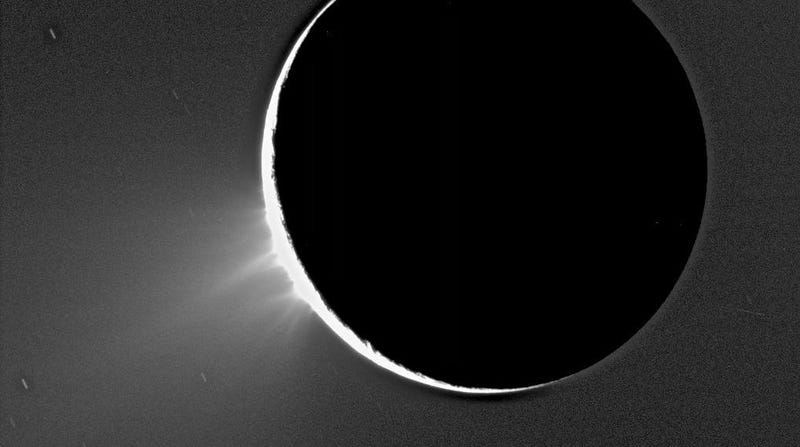 This image of Saturn’s moon Enceladus, taken by the Cassini probe in 2005, shows plumes of material over its south pole.Image: NASA/JPL/Space Science Institute
This image of Saturn’s moon Enceladus, taken by the Cassini probe in 2005, shows plumes of material over its south pole.Image: NASA/JPL/Space Science Institute
How did life first start? Scientists hoping to answer that question are recreating the conditions of early Earth’s oceans in a lab.
NASA researchers showed that systems with specific kinds of iron dissolved in water, which could have been common on the early Earth seafloor, could have assisted in the creation of the molecules that turned into life. Understanding these reactions could be important in understanding the emergence of life on our own planet—or even the potential for alien life beneath the ice of certain moons around Saturn and Jupiter.
“We’ve shown that in geological conditions similar to early Earth, and maybe to other planets, we can form amino acids and alpha hydroxy acids,” molecules like lactate, “from a simple reaction under mild conditions that would have existed on the seafloor,” Laurie Barge, astrobiologist at NASA’s Jet Propulsion Laboratory in Pasadena, California, said in a press release.
Along the seafloor are hydrothermal vents that spew hot fluid into the ocean out of rock chimneys, creating temperature, chemical, and acidity gradients that might provide a source of energy for life-producing chemical reactions. NASA Jet Propulsion Laboratory scientists recreated this environment using iron, ammonia, and the simple organic molecule pyruvate dissolved into water from which all of the dissolved oxygen had been removed (to simulate the anoxic conditions of the early Earth). They slowly added the chemical sodium hydroxide in order to adjust the acidity of the mixture, and then let the sample sit either at room temperature or in a bath of hot water. They also attempted the experiment using miniature chimneys grown from iron hydroxide, rather than mixing the iron and sodium hydroxide into the water.
After three days, the researchers found that in the experiments in which all of the chemicals were dissolved in the water, some of the pyruvate had turned into the amino acid alanine and some turned into the chemical lactate. How much alanine or lactate formed depended on the temperature, amount of electrons contained by the iron atoms, and the acidity of the water. No alanine formed in the experiment using the miniature chimneys, though sometimes lactate formed—and the researchers commented that perhaps given a whole lot more time, alanine would have formed eventually.
So, technically the researchers didn’t recreate life in a beaker, and we don’t know whether the conditions in the lab were the same as those on the early Earth or beneath the ice on moons like Europa, where some speculate life might have formed in this way. They did show that an amino acid, the building block of the proteins which are in turn a central component of life as we know it, can form in lab models of early Earth conditions, according to the paper published in the Proceedings of the National Academy of Sciences. That is, provided the acidity, chemistry, and temperature conditions are correct.
Perhaps the conditions beneath the ice on Jupiter’s moon Europa or Saturn’s moon Enceladus are like the conditions presented here. If that’s true, then perhaps life really could have gotten started there, even without sunlight to provide a source of energy. We won’t know for sure without visiting.
Share This Story